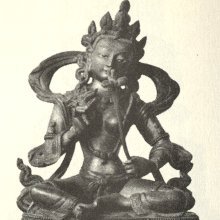T, Ṭ: 3 definitions
Introduction:
T means something in Hinduism, Sanskrit, Hindi, Tamil. If you want to know the exact meaning, history, etymology or English translation of this term then check out the descriptions on this page. Add your comment or reference to a book if you want to contribute to this summary article.
Images (photo gallery)
(+26 more images available)
In Hinduism
Vyakarana (Sanskrit grammar)
Source: Wikisource: A dictionary of Sanskrit grammarṬ (ट्).—The first consonant of the lingual class (टवर्ग (ṭavarga)) possessed of the properties श्वासानुप्रदान, अघोष, विवृतकण्ठत्व (śvāsānupradāna, aghoṣa, vivṛtakaṇṭhatva) and अल्पप्राणत्व (alpaprāṇatva). When prefixed or affixed to an affix as an indicatory letter, it signifies the addition of the fem. affix ङीप् (ṅīp) (ई); cf. P. IV. 1.15, When added to the conjugational affixes (लकार (lakāra)) it shows that in the Atmanepada the vowel of the last syllable is changed to ए. cf. P. III. 4.79. When added to an augment (आगम (āgama)), it shows that the augment marked with it is to be prefixed and not to be affixed; e. g. नुट्, तुट् (nuṭ, tuṭ) etc.; cf P. I. 1.46.
--- OR ---
T (त्).—The first consonant of the dental class of consonants which has got the properties श्वासानुप्रदान, अघोष, विवृतकण्ठत्व (śvāsānupradāna, aghoṣa, vivṛtakaṇṭhatva) and अल्पप्राणत्व (alpaprāṇatva). When used as a mute letter by Panini, त् (t) signifies the Svarita accent of the vowel of that affix or so, which is marked with it: e. g. कार्यम्, हार्यम्, पयस्यम् (kāryam, hāryam, payasyam) cf. P. VI.1.185. When appied to a vowel at its end, त् (t) signifies the vowel of that grade only, possessed by such of its varieties which require the same time for their utterance as the vowel marked with त् (t), e. g. आत् (āt) stands for आ (ā) with any of the three accents as also pure or nasalised; आत् (āt) does not include अं (aṃ) or अ (a) 3 cf. तपरस्तत्कालस्य (taparastatkālasya) P. I. 1. 70. The use of the indicatory mute त् (t) for the above purpose is seen also in the Pratis akhya works; cf. V. Pr. I. 114 R. T. 234.

Vyakarana (व्याकरण, vyākaraṇa) refers to Sanskrit grammar and represents one of the six additional sciences (vedanga) to be studied along with the Vedas. Vyakarana concerns itself with the rules of Sanskrit grammar and linguistic analysis in order to establish the correct context of words and sentences.
Languages of India and abroad
Sanskrit dictionary
Source: Cologne Digital Sanskrit Dictionaries: Shabda-Sagara Sanskrit-English DictionaryT (त्).—The first consonant of the fourth or dental class, corresponding to the letter T, in tongue.
Sanskrit, also spelled संस्कृतम् (saṃskṛtam), is an ancient language of India commonly seen as the grandmother of the Indo-European language family (even English!). Closely allied with Prakrit and Pali, Sanskrit is more exhaustive in both grammar and terms and has the most extensive collection of literature in the world, greatly surpassing its sister-languages Greek and Latin.
Hindi dictionary
Source: DDSA: A practical Hindi-English dictionary1) T in Hindi refers in English to:——the first letter of the third pentad (i.e. [tavarga]) of the Devnagri: alphabet..—t (ट) is alternatively transliterated as Ṭa.
2) T in Hindi refers in English to:——the first letter of the fourth pentad (i.e. [tavarga]) of Devnagri: alphabet..—t (त) is alternatively transliterated as Ta.
...
See also (Relevant definitions)
Starts with (+9980): Atum, Boar tooth, Bodhidharma, Campakapupphiya, Dhammasattha, Dhammayuttika Nikaya, Golden Fishes, Jarenere, Lower Egypt, Monkey tooth, Non-yogin, Punna, T grass, Ta, Ta cham diang, Ta chi, Ta ching, Ta cige, Ta det, Ta deu.
Ends with (+9980): A kon-korot, A-noet, Aaddt, Aagat, Aaghat, Aahat, Aahvaan-geet, Aakhet, Aakhyaanak-geet, Aakhyaat, Aakhyat, Aant, Aapat, Aapatvipat, Aapt, Aapurit, Aarany-kukkut, Aararoot, Aashcharyachakit, Aasphot.
Full-text (+8755): Takara, Kashthataksh, Adhiraj, Varhishat, Ta, Curi, Sarat, Visata, Yudh, Alpaprana, Tit, Vidyut, Kshudh, Viprush, Dayakrit, Kalabhrit, Majjakrit, Viyat, Samit, Mahikshit.
Relevant text
One of your search terms exceeds the minimun character amount per search term. This amount currently equals 2.
No search results for T, Ṭ in any book or story.
Related products
(+75 more products available)











